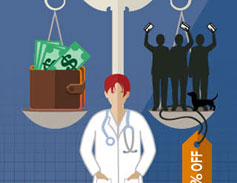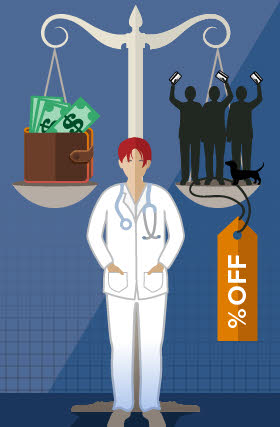Publisher Time Inc. enters veterinary-discount realm

Pet owner clubs

Digital art by Tamara Rees. Sources: Adobe Stock/ylivdesign; Shutterstock/TravisKlein; Michele Paccione
Veterinary practices that give discounts to members of the pet owners' club Pet Assure will see more clients eligible for the discount if a new venture by the media company Time Inc. is successful.
Time Inc. has created a club called PetHero that uses the same network of veterinarians as Pet Assure. Pet Assure was founded 22 years ago and has been under its current ownership since 2007. According to company executives, their "DVM Network" has 5,650 practitioners and is growing by about 15 percent per year.
Practices belonging to the network run a gamut from enthusiastic participants to reluctant enrollees that felt pressured by clients to join. The potential expansion of discounting brings to the fore perennial concerns in the veterinary community about pricing, affordability and the perceived value of veterinary medical services.
For Time Inc., establishing PetHero is a way to diversify its business and enter the pet-products market, often touted as lucrative and growing. The market surpassed $60 billion in 2015, according to the American Pet Products Association. PetHero, which debuted in late July, is Time Inc.'s first foray outside the media industry.
Anup Swamy, senior vice president of consumer market development at Time Inc., said the idea of creating a club providing pet owners with discounts for veterinary care and drugs, along with seasonal boxes of toys and treats, was conceived eight months ago. "Our team looks for big segments or industry verticals where we think there's an opportunity for us to expand based on existing assets or customer audiences we think we have. Pets popped to the top," Swamy said.
In a news release, the company notes that its digital and print media reach more than 100 million consumers who own pets or are pet lovers, and "engages with them regularly with content on pet wellness and health, human interest, food and celebrities and celebrity pets."
A PetHero membership costs $60 per quarter or $240 per year for a single cat or dog. Additional pets are $15 more per quarter or $60 per year.
Rather than build its own network of participating veterinary practices, Time Inc. solicited Pet Assure as a partner.
Charles Nebenzahl, president and CEO of Pet Assure Corp., said he ignored the first email from the media company, thinking it was a solicitation to buy advertising space. "I didn't think it was for real," he said.
Time Inc. persisted, and the two companies ultimately formed an alliance. Nebenzahl said Time Inc. pays Pet Assure a small sum — less than 5 percent of the retail price — per subscriber for access to its veterinarian network. Further, Pet Assure anticipates benefits from Time Inc.'s "huge reach to pet owners." Nebenzahl said, "We see this an an opportunity to become a household name" because PetHero subscribers will know Pet Assure is behind the veterinary plan.
Although not technically pet insurance, Pet Assure does share with insurance the attribute of being a "veterinary plan." Exposing more pet owners to the idea of a veterinary plan is another benefit Pet Assure sees in the partnership. Through Time Inc.'s marketing to potentially millions of U.S. consumers, Nebenzahl said, "Veterinary plans will become an accepted concept, just like dental plans and vision plans in human health care."
Up to now, Nebenzahl said, Pet Assure has reached pet owners chiefly through their employers, through whom two-thirds of its 200,000 members subscribe. The majority of participating employers deduct the membership fee from the paychecks of employees who elect to join. As a perk, a few employers offer to subsidize or pay for a membership.
At the end of 2016, more than 6,000 employers included Pet Assure in some fashion as part of a benefits package, Nebenzahl said.
"From a veterinarian perspective, these are class A customers," he said: "They're employed; they've made a monthly commitment, so they're committed pet caretakers. Just by virtue of the fact that they're seeing the [membership] amount deducted [from their paychecks] makes them want to use it. It's human nature — they're already getting the discount, so they're not negotiating [prices] with the veterinarian. When people have a coupon, you might say, they want to use it."
Participating clinics see pros and cons
Dr. Dan Otto, owner of a practice in Lincoln, Nebraska, agreed that pet owners who sign onto Pet Assure through their employers tend to be good clients. Otto joined the network in 2008 when he purchased the practice and was looking to build business. His goal then and now, he said, was simply to "get them in the door."
Referring to the transitory nature of clients caused by the relatively short lifespans of pets, Otto said, "We lose them every 10 to 12 years, [and] we've got to replace them. So you've got a big hole in the bottom of your bucket that you've got to continue to pour new clients into." Being listed in Pet Assure's directory helps to keep that bucket filled, he said.
Other practices report less positive experiences.
Phyllis Webster, manager of a practice in Ellisville, Missouri, said she'd been aware of Pet Assure for years but wasn't interested. Then an existing client who had obtained a membership through her employer asked the practice to participate. "She said, 'If you don't accept this card, I'm going to seek veterinary care elsewhere,' " Webster said.
Under pressure, the practice joined. That was about two years ago. Webster said the clinic has seen a half-dozen new pet owners come in as a result, but only two became regulars. The other four came from a distance, 30 miles or more, and visited only once. Webster believes they found that they'd miscalculated the price savings.
"These people come in thinking they get 25 percent off everything, and they do not," she said.
Pet Assure discounts apply to in-house medical services such as examinations, vaccinations, dental X-rays, surgeries and medications administered on-site. But medications sent home, outsourced services such as laboratory diagnostics, and non-medical services such as boarding and grooming, aren't discounted. The same is true for PetHero.
Club members get a 15 percent discount on prescription drugs and related products such as parasite control and supplements from the online pharmacy PetCare Rx. That's a potential sore point for veterinarians, many of whom regard internet veterinary pharmacies and retail drug stores as competitors.
Acknowledging veterinarians' concern, Pet Assure's Nebenzahl said the PetCare Rx discount "is not something we promote that much." He added: "From what we've seen talking to consumers, no one is saying, 'Oh, I was going to get it from the vet but now that I'm getting a discount, I'm going online.' It's the consumer who was going online [anyway] who was going to go."
Dr. Howard Brown, a clinic owner in Canoga Park, California, had a different problem. He found Pet Assure so popular among his clients, he couldn't afford it. After he joined the network in 2013, existing clients by the dozens requested the discount.
"Word of mouth in the waiting room is what killed me," Brown said.
As he describes it, one waiting pet owner would say to another, "We're going to get a 25 percent discount on this, that and the other." The listener would ask how. The speaker would explain about the discount club.
"We find our regular clientele that we've had for eight or 10 years are now getting Pet Assure. Now they want [the discount]. Not only that, they're demanding it!" Brown said.
He found some would make decisions about their pet's care based upon the discount. For example, a client would insist on having blood work done in-house even if the pet needed the more extensive analysis provided by an outside lab.
"They didn't realize: If you don't do what needs to be done, it doesn't matter what the discount is, the cat is not going to get better," Brown said.
Brown estimates that only two to three percent of the practice's active accounts were eligible for the discount, but the financial effect was such that he considered raising prices to compensate. "Then I realized that would probably hurt me more," he said.
His solution was to quit the network. To attract new clients, he uses to his advantage the thing that gave him grief with Pet Assure: word of mouth.
Who pays for the discount, and how?
Brown's experience with the discount network is exactly what several veterinarians deplored about the concept in a message-board discussion of the Veterinary Information Network, an online community for the profession.
"You basically are giving away most if not all of your profit. Not for me, ridiculous," Dr. Melanie Moore, a practice owner in North Carolina, said in a post in 2014.
"... I think you'd have to increase prices to facilitate that," said Dr. Meg Formoso, a practice owner in Florida.
According to Pet Assure, the average discount provided by participating veterinarians amounts to 10 to 12 percent annually because not everything is eligible. That's still perceived by some as too high.
"From a practice owner perspective, that is one hell of a 'fee' —12 percent per client per year. Ouch!!! I always have a question when I see this kind of 'proposal.' Where the heck do these companies like Pet Assure think that money comes from or goes?!?!?!!?!?!?!?!" wrote Dr. Mary Songster-Alpin, who practices in New York state.
Pet Assure says the money comes back to practices in the form of greater spending by club members. That's what they hear anecdotally from some participating veterinarians, Nebenzahl said. The company asserts in marketing materials, "They regularly spend annually as much as 50 percent more than the practice’s other clients."
Gina Gomez-Vidal, a certified veterinary technician and hospital manager of East Valley Animal Hospital and Anasazi Animal Clinic in Gilbert, Arizona, attests that club members do tend to spend more. The practices joined the network 1½ to two years ago, and grants the discount to about 10 percent of clients.
"Because they get a discount, they're willing to do more diagnostics and dentals and routine stuff," Gomez-Vidal said. "... They're part of this because they want to do more for their pets, not because they don't want to."
For that reason, she believes that if the clinics' entire clientele were eligible for the discount, the program still would be sustainable. But in that case, why not just lower prices for everyone and skip the discount?
Gomez-Vidal doesn't think that would have the same effect, owing to the peculiar psychology of consumers. By having to buy the discount through their club membership, she believes, they value it more and want to use it more often. If lower prices simply were available to all, Gomez-Vidal said, "I think it wouldn't be as important to them because they just get it, no matter what."
One aspect about participating in the network does give Gomez-Vidal pause. Three other hospitals in the network are located within roughly seven miles of the two clinics she manages. Three participating mobile practices also serve the area. If still more practices were to honor the discounts, what would distinguish one from the other in the eyes of new club members?
"My question for Pet Assure is, can we limit it to how many veterinarians are in each ZIP code to make sure we still have an edge?" Gomez-Vidal said. "It would definitely be a concern if they start growing exponentially."
Pet Assure chief Nebenzahl said the company aims to be a friend of the veterinary community, so it would not turn away any practice that wished to join, but added, "When a given area has sufficient veterinarians in the network, we stop marketing there."
What's sufficient? Nebenzahl's working definition is 20 percent of veterinarians within "reasonable driving distance" of a subscriber's home. He estimates that overall, 9 percent of the nation's independent practices are in the Pet Assure network.